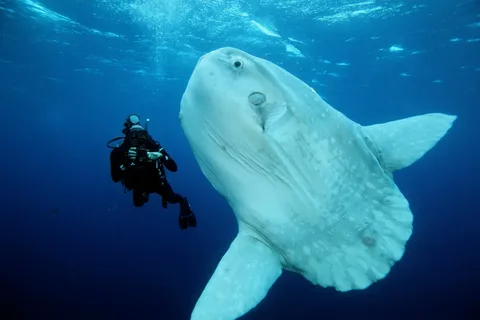The ocean sunfish, also known as Mola mola, is one of the most fascinating and peculiar creatures that inhabit the world’s oceans. With its massive, flattened body, unusual shape, and unique behavior, the ocean sunfish often draws the curiosity of marine enthusiasts, scientists, and casual observers alike. But what is this enigmatic species, and how does it manage to survive in the deep and sometimes harsh conditions of the ocean? In this article, we’ll dive into the biology of the ocean sunfish and uncover the survival strategies that allow it to thrive in the depths of the sea.
What is an Ocean Sunfish?
The ocean sunfish is the largest bony fish in the world, reaching an average size of 10 feet (3 meters) in length and weighing up to 2,200 pounds (1,000 kilograms). Despite its size, it has a very distinctive appearance. Rather than the streamlined shape you might expect from most fish, the ocean sunfish has a flattened, disk-like body with a small mouth and a tail that resembles a rudder, often referred to as the “clavus.”
This unique shape is a result of its evolutionary adaptations, which help it navigate the vast expanse of open ocean. Sunfish are found in temperate and tropical oceans around the world, often near the surface, where they feed and bask in the sun’s warm rays. Their name “sunfish” comes from their behavior of floating on their sides near the water’s surface, absorbing sunlight, a behavior that is crucial to their survival.
The Ocean Sunfish’s Feeding Habits
Ocean sunfish are omnivores, primarily feeding on jellyfish, small fish, and even the occasional plankton. Their diet is particularly focused on gelatinous creatures like jellyfish, which are abundant in the ocean. Interestingly, sunfish have specialized, fused teeth that form a beak-like structure, which allows them to puncture and consume these soft-bodied prey.
One of the most remarkable aspects of the sunfish’s feeding habits is its ability to consume enormous quantities of food in a short period. To sustain their massive bodies, sunfish need to consume up to 20% of their body weight in food every day. Their stomachs are large and capable of holding vast amounts of food, making them well-equipped to devour their favorite delicacy—jellyfish. However, since jellyfish are low in nutritional value, the sunfish must eat constantly to maintain their energy levels.
Survival in the Deep Sea: How Do They Adapt?
Though sunfish are typically seen near the ocean surface, they have the ability to dive deep into the ocean as well. To survive in the deep sea, where conditions can be extreme, sunfish have evolved several unique adaptations that ensure their survival in both the upper and lower layers of the ocean.
- Temperature Regulation: One of the key challenges of surviving in the deep sea is the wide variation in temperature. Sunfish are ectothermic, meaning they rely on external sources of heat to regulate their body temperature. To cope with cooler temperatures in deeper waters, ocean sunfish can utilize a special ability to regulate their internal temperature. By diving into deeper, cooler waters to hunt for food and then returning to the surface to bask in the sun, sunfish can maintain a favorable temperature range for their metabolism.
- Efficient Movement: Despite their bulky, unconventional shape, ocean sunfish are skilled swimmers. They use their large dorsal and anal fins to propel themselves through the water, while their tiny tail fin (clavus) acts as a rudder for steering. This method of swimming allows them to cover great distances, which is essential in their search for food across vast ocean expanses.
- Body Shape and Energy Conservation: The unique body shape of the ocean sunfish is an energy-efficient design for surviving in the deep sea. Its flattened body reduces drag and enables the fish to move more effectively through water. Additionally, the sunfish’s lack of a traditional tail fin (replaced by the clavus) reduces energy expenditure, allowing it to maintain longer swimming sessions without tiring easily.
- Protection from Predators: While ocean sunfish are generally solitary, they are often subject to predation by larger marine animals like sharks, orcas, and certain species of large fish. However, their size and ability to swim rapidly help deter most predators. Additionally, their tough, leathery skin and ability to rapidly dive to great depths serve as protective mechanisms against potential threats.
The Ocean Sunfish’s Relationship with the Ecosystem
The ocean sunfish plays an important role in its ecosystem. As a predator of jellyfish, it helps to regulate their populations, preventing jellyfish from overwhelming marine environments. Jellyfish blooms, when left unchecked, can damage local fisheries and ecosystems by outcompeting other species for food and space. By consuming large amounts of jellyfish, ocean sunfish help maintain a healthy balance in the food chain.
Moreover, the sunfish itself is an essential part of the marine food web, providing a food source for larger predators. Their unique feeding behaviors also contribute to the nutrient cycle in the ocean by disturbing and dispersing smaller organisms and plankton in the water column.

Threats to Ocean Sunfish
Despite their impressive adaptations, ocean sunfish face numerous threats. Overfishing, entanglement in fishing nets, and the destruction of marine habitats all contribute to their declining populations in some regions. Climate change, with its impacts on ocean temperatures and currents, also poses a risk to the sunfish, as it could alter the distribution of their prey and affect their migration patterns.
Additionally, the rise in plastic pollution has had detrimental effects on ocean life, and sunfish are no exception. They are known to ingest plastic debris, mistaking it for food like jellyfish, which can lead to fatal blockages and other health issues.
Conclusion
The ocean sunfish is a true marvel of nature—an unusual yet highly adapted survivor of the deep sea. From its extraordinary size and shape to its remarkable feeding habits and survival strategies, the sunfish has found its niche in the vast and complex ocean ecosystem. As a critical player in marine food webs, the sunfish helps maintain balance in its environment, showcasing the intricate and interconnected nature of life beneath the waves. As we continue to learn more about these enigmatic creatures, it is crucial that we work to protect their habitats and ensure the health of our oceans for generations to come.



